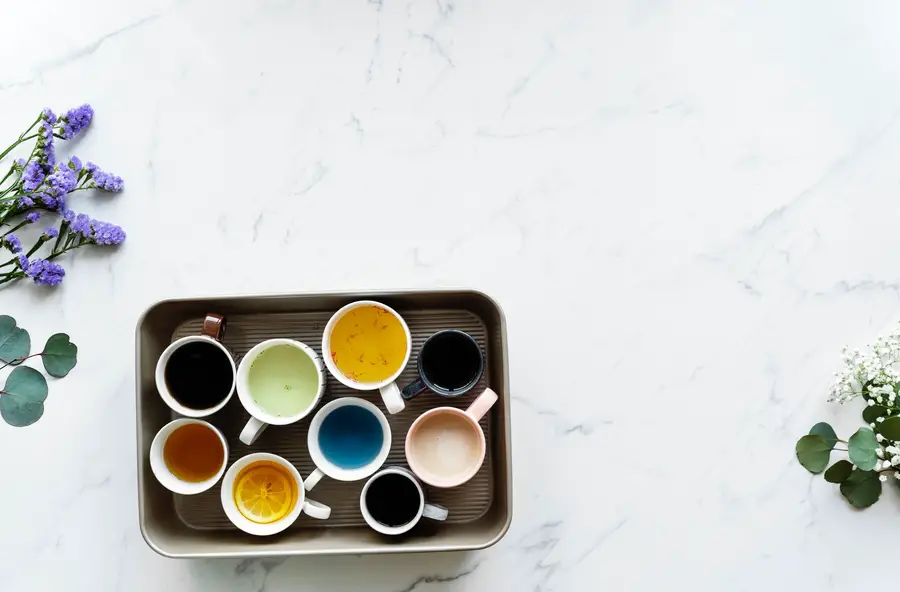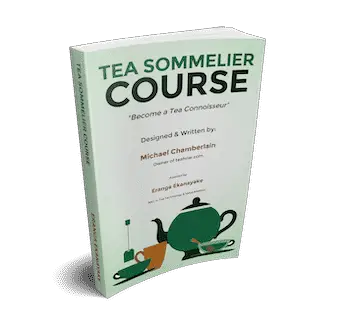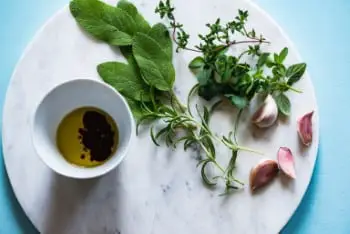When I drink tea, I actually don’t pay that much attention to the precise chemical mix, it’s more about the taste and other benefits it brings, health-wise and dare I say … spirit-wise! But I decided to research the levels of caffeine a bit in the teas, particularly green tea!
Does Green tea contain caffeine? In an average 8oz cup of pure green tea, there will be about 25mg of Caffeine. Avoid drinking within two hours of going to sleep, and keep quantities low to avoid nighttime toilet visits.
The question then is, how does this compare with other teas? Is it more? Or less? Let’s look more in-depth to get further context around this.
I’ve written extensively about caffeine levels in various types of teas which I’ll add links to further down to help with your search on reducing caffeine before bedtime.
Green tea caffeine Levels Can Vary
There are many variables in your average cup of green tea to be wholly accurate. Few of us are so scientific about making a cup of tea that we’d measure out the exact ingredients. Then time the exact steeping seconds and control the water temperature needed. Let alone take an initial measure of the starting amount of caffeine present in the tea beforehand.
On that point, there are further variables even before getting to your infuser. Teas are grown in different conditions.
For example; if green tea is ‘shade grown’, the plant actually produces more caffeine. They react to the lack of sunlight more, by increasing their levels of chlorophyll and other chemicals – Caffeine being one of them
Caffeine occurs in higher levels in yerba mate, Gyokuro, and Matcha Green tea, as it’s Green tea in powder form.
Powdered teas are ingested as a suspension in the water, rather than an infusion. This means you’re ingesting the full dose of Caffeine available, rather than a residual amount released into the water.
This is why it’s very hard to predict the amount of caffeine present and also why companies are quite vague on this detail. In fact, it could be anywhere from 15mg to 75mg.
From The Same Tea Plant
What we do know, is that all Teas are harvested from the same tea plant, Camellia Sinensis. Therefore, although there will be variances, they will all naturally contain Caffeine.
This busts the myth that there are naturally occurring Decaf Teas, there just aren’t unfortunately. They would need to undergo a further processing stage to make them Decaf and even then, there will STILL be caffeine present.
In fact, it’s surprising how much caffeine remains. I discuss this more in my post on herbals tea and caffeine.
Neither is it true that you can make them Decaf by infusing them once as a quick ‘blanching’ effect, then infuse again. This has been scientifically proven not to be the case, as caffeine doesn’t (apparently) purge completely in the first infusion – which kind of makes sense.
Green Tea Process Variables
During the processing of teas, different teas are often broken up into different grades, or, sizes of leaves. This includes grades with such names as; Dust, Fanning, and Broken Orange Pekoe.
Generally speaking, the more ‘broken’ the leaves, the more surface area of the plant is accessible. This, in turn, means the level of Caffeine can be higher.
The net result is that teas have a larger scope of Caffeine levels and there are almost certainly overlaps. Mostly, following Laboratory tests, tea producers provide an “average”, based on a large sample of data.
How Much Caffeine is in Green Tea Compared to Coffee
Compared to Coffee, Green Tea has less Caffeine, typically 1/4 of the amount of caffeine you’d find in a typical cup of coffee 25mg, compared to 108mg.
Not only that but amino acids that are present in green tea help to offset the onslaught of the ‘Caffeine Rush’.
So with tea in general, this means caffeine is accompanied by a slow-release mechanism that negates the hyper stage of coffee. In general, it’s slower to release the caffeine, and also, the climb down is much slower too – no crashing!
It’s also supposed to be a good level of caffeine to perfectly aid concentration levels.
How Much Caffeine in Green Tea Compared to Other Teas

Green Tea has approximately, 1/2 of the amount of caffeine you’d find in a typical cup of black tea. Due to the processes mentioned earlier. But also as mentioned earlier, there is a lot of overlap.
Below I’ve listed some guidelines on what the Caffeine levels are in the main varieties of tea. Each example is for 236ml of water, 8 fl oz.

Herbal Tea: zero
Kombucha Tea: 24mg
Green Tea: 25mg
White Tea: 29mg
Oolong tea: 34mg
Black tea: 42mg
Matcha Tea: 70mg
Yerba Mate Tea: 85mg
Caffeine in other teas
Take a look at these other articles to discover more about caffeine levels in various types of teas.
Does herbal tea contain caffeine
10 Ways to Reduce Your Green Tea Caffeine Intake
If you’re looking for some ways to reduce your Caffeine intake but you still want green tea, then I’ve found some really interesting ways you can do this and listed them below…
- Decaf Green Tea – impossible to ‘make’ at home. But you can buy decaf tea ready for steeping. it will still have an element of Caffeine in it, but it will be much reduced.
- Decaf subscription boxes – Many Tea Subscription boxes these days contain tea options for Caffeine Free tea. Again there will be lower, or residual caffeine levels, but it’s a much more reduced caffeine option
- Go For Blends – if you’re within a reasonable distance of a tea blending store or a Tea Sommelier, then they may be able to provide you with a mix that reduces the amount of green tea but introduces other herbal teas or tisanes into the mix as well. Plus it’s really tasty when mixed with Lemongrass or Mint.
- Avoid Matcha – Powdered teas like Matcha contain greater amounts of Caffeine as you are ingesting the leaf. Avoid these to lower your Green Tea Caffeine levels.
- Avoid Shade Grown – Tea plants grown in the shade produce a higher level of caffeine, avoid these to reduce your caffeine intake.
- Avoid Coffeehouse Tea – try and stay clear of the coffee house mix of teas, in general, and as you can imagine, there’s little regard for Caffeine levels in coffee houses, so they’re less likely to be knowledgeable on caffeine levels in tea.
- Herbal Teas or Tisanes – as a natural replacement, you could try herbal teas instead. which for the most part have zero, or almost zero caffeine.
- Twig Tea – also known as bōcha (or kukicha), is produced using the stems of the Camellia Sinensis plant. They’re naturally lower in Caffeine levels, which will greatly reduce the level for you. Teas of these sorts might be Kukicha or Houjicha.
- Avoid Tippy Teas – green tea that is made more from the plant tips of Camellia Sinensis tends to contain greater levels of caffeine, avoid these teas if possible.
- Brewing Temperature – avoid using boiling water on green tea, this will result in a greater release of Caffeine. It’s recommended to use water that is brought to Simmering, then steep it for around 90 seconds only.
To close…
To conclude then. Yes, green tea does contain Caffeine, it always does contain Caffeine. Plus it’s hard to predict the exact levels due to a large number of variables involved – but we do have a guide at least.
The key is comparing this to other teas and their levels and I’d say, on balance it’s certainly at the lower end of the Caffeine spectrum compared to most.
There are things we can do if we like our green tea and if we still want to reduce our Caffeine levels. If you’re on a few cups a day then, in all honesty, the amount of overall caffeine is not going to be a huge deal – depending on how purist you want to be.
My final thought would be not to let this minor detail overshadow the huge amount of benefits Green tea actually brings with it.
I hope this has been helpful in looking at what Caffeine level is in Green tea and what you can do to help reduce Caffeine in Green Tea. Don’t forget to check out my Tea Sommelier course…

Take the fast track and become a tea connoisseur
Whether for enjoyment or considering a career as a tea sommelier. This course has everything you need to enhance your tea knowledge and tea-tasting skills.
This course keeps it simple with step-by-step tea tasting and easy reference guides
For pleasure, or as a precursor to a career in the tea industry. Find out what tea sommelier actually does, their career paths, and what they earn.

Find out more about the Teahow Tea Sommelier Course!


Tea!!! I also love both but I couldn’t live without tea. I try to stay away from caffeine so that makes my options slightly more limited, and tea has so many more choices for decaf than coffee does (I also prefer iced coffee over hot). I love anything fruity, decaf green tea, and lemon black tea. There are very few teas that I dislike other than chai!
Thanks Chuck, yes, I’m asked a lot about Caffeine in Tea, really it’s small in comparison to coffee. Glad the chart was of use to you.
Ok, I have to admit it. I have wondered about the level of caffeine in my tea many times. I really needed the chart for a comparison to the coffee I USED to drink. Thank you! I had always assumed green tea had a negligible amount of caffeine.